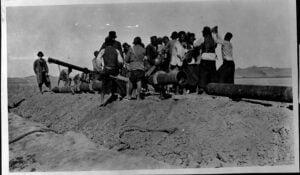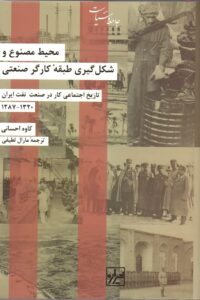The Built Environment and the Making of the Industrial Working Class:
The Social History of Labor in the Iranian Oil Industry (1908-1941)
Kaveh Ehsani
Shirazeh Publishing House, Tehran: 2020[1398]
Kaveh Ehsani is assistant professor of international studies at DePaul University and a contributing editor of Middle East Report.
In the absence of explicitly spatial historiographies of Iran, we definitely should celebrate the publication of Ehsani’s pioneering work in Persian which fills a vital gap in the literature. His work is a social history of labor in the Iranian oil industry, with a specific focus on space/geography. Ehsani’s theoretical framework is an eclectic combination of Marxist – most specifically, David Harvey – and poststructuralist urban/spatial perspectives. His entry point is urban, spatial, and geographic. Ehsani is highly influenced by actor-network theorists like Deleuze and Guattari, Bruno Latour, and specifically, by Timothy Mitchell. Ehsani argues that we need to consider the history of oil as one of an ‘assemblage’ rather than one of ‘emergence’. While the latter denotes a biological and natural progression, the former highlights the role of human praxis, Ehsani explains.[1]It should be noted that ‘emergence’ has different meanings and connotations. Among others, one can refer to the concept of emergence in Roy Bhaskar’s critical realism which has an entirely … Continue reading It is also argued that “assemblage frames the history of oil as the outcome of social and historical ‘encounters’1 between the material world and the actions of different and unequal social actors” (Ehsani, 2020[1398]: 19). Using this terminology, Ehsani claims that the material world can be considered as a social ‘actor’. This approach allows us to go beyond dualistic views of nature-society which in one way or another objectify nature as inanimate, passive, and subject to the human/social. These dichotomous perspectives are the embodiment of an ‘exercise of power’ that needs to be deconstructed.
The book is divided into 7 chapters. In the first chapter, Ehsani elaborates on his theoretical frameworks and major concepts. Chapter 2, “The Historical Geopolitics of Oil in Khuzestan”, examines the national reconfiguration of the Persian Gulf and Iran for a global imperial politics that was led by Britain that in the wake of WWI for the first time appeared as the dominant power. Chapter 3, “The Oil Encounter in Khuzestan (1908-1921)”, investigates the integration of local agrarian and pastoral societies and landscapes into the global circuits of oil capitalism. The chapter’s focus is on the politics of property and legal contract as primary means in the subjugation of these societies to oil capitalism (p. 92). Chapter 4, “WWI and its Aftermath: The Emergence of the ‘Social Question’ and its Impact on the Oil Complex (1914-1926)”, shows how the British state underwent a profound transformation in the course of WWI in response to the rise of mass politics, the professional middle class, anti-colonial nationalism, and the advent of Fordism. This chapter discusses the formulation of ‘the social’ question which led to the emergence of the welfare state. Chapter 5, “Reluctant Paternalism and the Social Question in Khuzestan’s Oil Complex in the Post War Era”, explores the context of the rise of the ‘social question’ in Khuzestan from the perspective of the Oil Company and the fledgling central government of Iran. Chapter 6, “The Making of an Oil City (1924-1927)”, analyzes a range of new urban solidarities that emerged in Abadan in the interwar years to resist further dispossession by oil capitalism, and to demand the ‘right to the city’. Finally, Chapter 7 provides a conclusion to the social history of Abadan, the province, the oil complex, and the laboring classes in oil through the interwar years. (p. 94)
Several key arguments are recognizable in the entire work, most of them have been developed in response to the methodological shortcomings of conventional historiographies (and more specifically, social histories of oil). First, it is argued that the new social order of petroleum is the end product of intentional but contested acts of assemblage, and not the natural progression of the evolutionary history of the capitalist industrial order (p. 23). Relatedly, it is stated that the Anglo Persian Oil Company (APOC) justified its operations in Khuzestan by resorting to a particular narrative that pictures southwest Iran as a natural setting, empty of population. Criticizing the teleological approach of modernization theories that celebrate urbanization as inherently progressive, modern, and inevitable, Ehsani sees the urban history of Abadan “not as a celebrated byproduct of the forward movement of history toward an ideal type modernity, but as a site of ongoing political and social tensions, struggles, and negotiations” (p. 38-39). Secondly, criticizing the dominance of the meta-narrative of Eurocentric modernization in oil historiographies, Ehsani aims to provide a micro-history which instead of macro-agents like state, elites, and formal institutions, is mostly focused on the everyday experiences of oil workers to avoid the widespread removal of their lived experiences. This challenges the conventional blindness to the integral role of labor and enables us to transcend the reification of oil as an abstract historical agent that shapes politics and economics on its own. At the same time, it is attempted not to focus on one level[2]Ehsani uses level and scale as identical to the detriment of others. Moreover, conventional social histories of labor in the oil industry tend to focus on workplace relations. This focus, as Ehsani says, can occlude what takes place outside the places of production. He alternatively puts his analysis under the category of what is known as the Global Labor History (GLH). It is argued that this approach “mounts a challenge to both nationalist and diffusionist historiography, by emphasizing relations and connections between various scales of analysis” (p. 42). This view does not reduce local dynamics to mere case studies proving the universal/global rule.
The book is full of fruitful historical details which are emanated from excavating a range of primary materials including archival sources and official reports. These materials are crucial for every student of comparative world history. Using archival materials including historical photographs of Abadan, Masjed Soleyman, Ahvaz, and a few other locations, has enriched Ehsani’s work. Employing these sources, he has developed a local  history of oil capitalism which narrates the contested, relational, and multiscalar process of forced imposition of capitalist market economy and wage labor on Khuzestan. Ehsani’s work is specifically rich in addressing the shifting processes of property relations, land ownership, and land transfer contracts in southwestern Iran and the Bakhtiyari highlands, and also the registration of all tribal territory as Khaleseh or state land after the intrusion of the central government. A historical review of legal regimes of property is thus provided. Most importantly, Ehsani’s historical narrative is spatial. He excavates the historical transformation of labor relations of Khuzestan in a particular conjuncture through the built environment of the ‘oil complex’. Ehsani employs the ‘oil complex’ as distinct from the oil industry and the oil sector to include the wider social and spatial relationships that surrounded oil. This concept allows us to incorporate the material and spatial[3]Ehsani does not differentiate between the material and the spatial. The same undifferentiated approach is evident in his utilization of concepts like place, land, territory, and space. Such an … Continue reading transformations that paved the way for the consolidation of the oil industry. He tries to demonstrate the relation between the working place and the space of reproduction of labor which is defined as the urban built environment of the oil complex. As Ehsani shows, “the accumulation of capital in oil was predicated on the production of a new built environment on the ruins of the dispossessed Bakhtiyari society.” (p. 202). This built environment includes an assemblage of oil towns (Aghajari, Gachsaran, Naft-e Sefid, Haftgel), ports (Khorramshahr/Mohammareh, Mahshahr), administrative cities (Ahvaz), railroad towns (Andimeshk, Doroud) with all their physical urban infrastructures (telephone and telegraph lines and pylons, roads and railroads, and pipelines, in addition to hospitals, dispensaries, and schools). Ehsani in this way indicates that the first round of capitalist industrial relations was introduced to Iran through a kind of oil-based capitalist urbanization. It is also shown that the formation of the oil complex in the region had led to an unprecedented built environment which functioned as a common ground for the ethnically disconnected residents to form effective instances of collective subaltern struggles over controlling and shaping the very physical space. (p. 60)
history of oil capitalism which narrates the contested, relational, and multiscalar process of forced imposition of capitalist market economy and wage labor on Khuzestan. Ehsani’s work is specifically rich in addressing the shifting processes of property relations, land ownership, and land transfer contracts in southwestern Iran and the Bakhtiyari highlands, and also the registration of all tribal territory as Khaleseh or state land after the intrusion of the central government. A historical review of legal regimes of property is thus provided. Most importantly, Ehsani’s historical narrative is spatial. He excavates the historical transformation of labor relations of Khuzestan in a particular conjuncture through the built environment of the ‘oil complex’. Ehsani employs the ‘oil complex’ as distinct from the oil industry and the oil sector to include the wider social and spatial relationships that surrounded oil. This concept allows us to incorporate the material and spatial[3]Ehsani does not differentiate between the material and the spatial. The same undifferentiated approach is evident in his utilization of concepts like place, land, territory, and space. Such an … Continue reading transformations that paved the way for the consolidation of the oil industry. He tries to demonstrate the relation between the working place and the space of reproduction of labor which is defined as the urban built environment of the oil complex. As Ehsani shows, “the accumulation of capital in oil was predicated on the production of a new built environment on the ruins of the dispossessed Bakhtiyari society.” (p. 202). This built environment includes an assemblage of oil towns (Aghajari, Gachsaran, Naft-e Sefid, Haftgel), ports (Khorramshahr/Mohammareh, Mahshahr), administrative cities (Ahvaz), railroad towns (Andimeshk, Doroud) with all their physical urban infrastructures (telephone and telegraph lines and pylons, roads and railroads, and pipelines, in addition to hospitals, dispensaries, and schools). Ehsani in this way indicates that the first round of capitalist industrial relations was introduced to Iran through a kind of oil-based capitalist urbanization. It is also shown that the formation of the oil complex in the region had led to an unprecedented built environment which functioned as a common ground for the ethnically disconnected residents to form effective instances of collective subaltern struggles over controlling and shaping the very physical space. (p. 60)
The ‘social question’ – epitomized in the establishment of the welfare state – shapes another essential point of reference in Ehsani’s work. He understands the social in a scalar way. It is explained how the unemployment crisis of the post-war years in Britain deteriorated the living conditions of the labor class and therefore caused labor unrests that were not limited to Britain or even Western Europe. These political struggles led to the emergence of the social question to the extent that “for the first time in history, housing was considered a right for the people, and the state was held responsible for it” (p. 285). At the same time in Khuzestan, urban problems and especially workers’ housing shortages significantly contributed to labor discontent. A particular consequence was that laborers and the poor demand employment and work as a social right. So, the expansion of social policies and the making of a welfare state in Britain was reflected and replicated in Khuzestan. As is said, “the social question emerged in Abadan in the interwar years, much like it had in post war Britain” (p. 366). This explains “why in the post-WWI era both APOC and the fledgling Pahlavi state eagerly justified the expanding range of their social interventions and urban infrastructural activities in the name of disinterested service for universal public welfare” (p. 313). The social question thus emerged as the state response to the reproduction of labor power which was manifested in the formation of welfare policies. Ehsani links this discussion of the rise of the social question to what he calls ‘reluctant paternalism’ which, bearing a resemblance to Gramsci’s passive revolution, refers to the “shift toward the adoption of a range of social policies by APOC as well as by the government bureaucracy … because of their top down authoritarian approach to urban and social improvement that were eventually adopted with hesitation” (p. 220).
Aside from all these fertile critical insights, there are some points in Ehsani’s work that one might take issue with. First, spatial categories of land, place, territory, and space, play a crucial role in Ehsani’s work. However, Ehsani uses them in a highly undifferentiated manner. Ehsani frequently puts land and space side by side without giving any clear explanation of their relationship. In some cases, he has used them interchangeably. For instance, when Ehsani is discussing the frictions between the Oil Company, the state bureaucracy, and local populations over the control of land, he argues that “land/space was the key resource for all these actors” (p. 151). This unspecified terminology has negatively overshadowed Ehsani’s whole project. According to Ehsani, by the mid-1920s, a new nationalist central government was being assembled in Iran that “was intent to forge a homogeneous nation state out of the fragmented territory and the heterogeneous population” (p. 69). Khuzestan “was always considered by whichever central government was in power as integral to its national territory” (p. 74). The problem is always formulated as “weakness of the Iranian central government” (p. 100-101) or “declining effectiveness of the administrative apparatus of the state” (p. 105). Nonetheless, spatially speaking, and if we want to bring Ehsani’s stated methodology to its logical end, it is more precise to describe the situation as an absence of a central government not just its weakness. A central state was spatially non-existent in Khuzestan, during the mentioned period. Ehsani refers to ‘national interests’, ‘national integrity’, and ‘national politicians’ as some fully realized phenomena which take ‘the national’ itself for granted.[4]There is one exception in the entire work of Ehsani when he says “the term “Iranian” or “Persian” is itself vague, especially in this period when a coherent and homogeneous national … Continue reading Although Ehsani aims to historicize, his confrontation with Iranian national territory is not sufficiently historicized. ‘Territory’ thus has been used in a vastly general sense which empties it out from its concrete geo-historicity. Ehsani speaks of the central government’s desire to impose its sovereignty on the national territory (p. 284). This, nonetheless, might seem primordialist since implicitly accepts the existence of Iran as a nation state as an ahistorical entity. The central government and national territory thus have been considered external to each other. This is despite the fact that Ehsani in several instances implicitly confirms that a national territory was only on the verge of formation in the early 20th century. For example, it is asserted that it was Britain that “controlled most of Iran’s border quarantine stations along the Gulf and the Iraqi borders until 1927” (p. 294). Or, he talks about Iran’s nominal independence and territorial integrity when the Anglo-Russian Treaty divided the country to spheres of influence. It is also stated that Iran “was conceptualized in British foreign policy not really as an independent country” (p. 61).[5]There are other historical facts that demonstrate the absence of national unified territory and a sovereign state at the time. There are several statements in Ehsani’s work that confirm this: … Continue reading Ehsani however does not consider the production of ‘the national’ as a very historical process which was itself in the initial phase of emergence.
Ehsani refers to both Lefebvre and Harvey as his main intellectual influences. However, he does not explicate their distinct and contrasting views. Citing Harvey, it is said that “a built environment has to be created before capital accumulation can start. The urban process is all about how this new landscape is produced and used” (p. 17-18). Or, it is maintained that the built urban environment of oil would facilitate the accumulation of capital (p. 340). So, in contrast to Lefebvre, the production of space itself is not considered as the very accumulation of capital, it is defined just as a facilitator of that. Furthermore, the urban question for Ehsani is characterized by the reproduction of labor – manifested in the Fordist built environment – and not a reproduction of relations of production as a whole. As he argues, we can “think of Company towns as corporate extensions of the disciplinary power exercised in coercive workspaces into the everyday urban spaces of reproduction” (p. 220, 317). Urban space in this sense is basically defined as a space of reproduction of labor and is therefore connected to the sphere of consumption, as is the case in Fordism and the mass consumer society, and not production in general. However, Lefebvre’s view on the production of space is different. For him, it is the secondary circuit of capital that has been dominated and internalized the industrial or primary circuit. In this sense, in contrast to what Harvey says, space is irreducible to the built environment and is not merely a background or foundation that makes capital accumulation possible. Lefebvre does not reduce space to the built environment – as something limited to the sphere of circulation. Harvey, contrary to Lefebvre who sees space as a force of production, reduces it to a means of production.[6]For a critical review of Harvey’s appropriation of Lefebvre’s ideas see: Gottdiener (1994). A concise selection of Lefebvre’s own theoretical insights on these aspects can be found in Lefebvre, … Continue reading
Ehsani occasionally refers to Lefebvre’s ‘the right to the city’. I found Ehsani’s eclectic application of Lefebvre’s ideas problematic. The problem, is mostly discernible where Ehsani contrasts Britain’s colonialism and Iranian nationalism. It is stated that “state-centered historiography tends to produce an anti-colonial and nationalist narrative” (p. 145). As a result, it might be inferred that colonialism is something that happens merely on an international scale and has nothing to do with nationalism. Thus, the nation-state form and nationalism might be absolved of colonialism. This view dismisses the very fact that nationalism itself is preeminently a reproduction of the colonial logic only at a different scale (See for example Goswami 2004). So Ehsani does not consider colonialism as a scalar social form. This approach prevents us from seeing the very production of the national scale as a new level of colonial reality. Hence, although Ehsani tries to link different geographic scales of analysis together he fails to transcend fixed and ahistorical conceptions of scale. Lefebvre helps us not to be trapped in nondialectical understandings of geographical scales.
Furthermore, Ehsani recourses to Marx’s idea of formal and real subsumption and argues that the history of Khuzestan in 1908-1911 reveals the process of real subsumption of the existing social order to the emerging oil complex.[7]Similar statements can be found elsewhere in the book, for example when Ehsani speaks of “the closure and violent demise of existing social and economic connections and indigenous modes of … Continue reading It is claimed that Khuzestan has been integrated into global capitalism that “irrevocably undermined the existing social and political economic agrarian, pastoral, and tribal orders” (p. 231). Such an explanation might induce the expression that we confront a complete transition to capitalism in Abadan. Although Ehsani opposes one narrative of transition (to modernity) which frames the histories of the local subaltern in terms of incompleteness and absences, he, at the same time, subscribes to another narrative of transition (to capitalism). It seems that Ehsani has an undialectical reading of Marx’s conception of formal subsumption. Referring to Marx, he says that the subjugation of labor to capital tends to begin as a formal process but eventually turns into a real subjugation (Ibid). The history of Khuzestan in 1908-1911 reveals, Ehsani says, the process of real subsumption of the existing social order to the emerging oil complex. Hrootunian[8]Harootunian (2015) bases his reading of Marx on the Grundrisse and contends that Marx “emphasized the coexistence of different economic practices in certain moments and the continuing persistence … Continue reading has questioned this reading by focusing on Marx’s later works. The point is that we have not experienced a replacement of traditional order (communal property) with a capitalist one (private property and wage labor). Instead, both old and new orders coexist. According to Harootunian, the perpetuation of the old in the new presents the general condition of subsumption. (Harootunian, 2015: 193)
All in all, Ehsani’s brilliant work in my view is the first attempt that has tried to incorporate space into the historical analysis. This makes his work distinct from the prevalent perspectives that treat space and scale as rigidly bounded, naturally given, and self-evident. So, Abadan has been defined in a multiscalar way that does not require drawing definitive boundaries. It is thus concluded that Khuzestan’s history ‘had never developed in isolation from the larger world’ (p. 73). Ehsani’s work has developed a novel analysis of the urban transformation of Abadan which shows “how the coercive commodification of urban space and everyday life created the material basis for a labor market … This urban built environment was thus the setting for the creation of a permanent wage laboring class, where one did not exist before” (p. 547-548). As I highlighted, this work is a must-read in several ways. I would like to conclude with quoting one of the most insightful explanations in Ehsani’s multiscalar comparative work: “without places like Abadan and Masjed Soleyman there would not have been a transition to Fordism of mass consumer production and consumption that was built on the foundations of cheap and plentiful petroleum”. (p. 546-547)
References
Elden, S. (2013). The birth of territory. University of Chicago Press
Goswami, M. (2004). Producing India: from colonial economy to national space. University of Chicago Press
Gottdiener, M. (1985). The social production of urban space. University of Texas Press
Harootunian, H. D. (2015). Marx after Marx: history and time in the expansion of capitalism. Columbia University Press
Hart, G. (2016). Relational comparison revisited. Progress in Human Geography, 42(3), 371–394
Hartwig, M. (2007). Dictionary of Critical Realism. London, Routledge
Lefebvre, H., Brenner, N., Elden, S., & Moore, G. (2010). State, space, world: selected essays. University of Minnesota Press
Bibliography
Ehsani, Kaveh (2020[1398]). Mohit-e Masnu‘ va Sheklgiriy-e Tabaghey-e Kārgar-e San‘ti: Tārikh-e Ejtemā‘y-ye Kār dar San‘t-e Naft-e Iran (1278-1320) (Maral Latifi, Trans.) [The Built Environment and the Making of the Industrial Working Class: The Social History of Labor in the Iranian Oil Industry (1908-1941).]. Tehran: Shirazeh
Endnotes
| ↑1 | It should be noted that ‘emergence’ has different meanings and connotations. Among others, one can refer to the concept of emergence in Roy Bhaskar’s critical realism which has an entirely different meaning and according to Hartwig, is defined as ‘the explication of an implicit or enfolded potential resulting in something hitherto absent from actuality.’ Emergence in this dialectical sense refers to ‘the constitution of a new, sui generis real, level of being.’ See: Hartwig, 2007: 86, 121 |
|---|---|
| ↑2 | Ehsani uses level and scale as identical |
| ↑3 | Ehsani does not differentiate between the material and the spatial. The same undifferentiated approach is evident in his utilization of concepts like place, land, territory, and space. Such an approach is problematic specifically given Ehsani’s own claimed methodological outlook which is supposed to be historical and geographical. For example, see Elden (2013) which has theorized land, terrain, and territory as historically and geographically distinct concepts/phenomena. |
| ↑4 | There is one exception in the entire work of Ehsani when he says “the term “Iranian” or “Persian” is itself vague, especially in this period when a coherent and homogeneous national identity had not yet been more systematically institutionalized” (p. 232). |
| ↑5 | There are other historical facts that demonstrate the absence of national unified territory and a sovereign state at the time. There are several statements in Ehsani’s work that confirm this: “there existed no official or systematic means of keeping records of mortality or births at the time” (p. 72); “by 1917 the government could no longer pay its daily expenses” (p. 73); when Ehsani says Khuzestan, was “a province that hitherto had lain virtually beyond the direct control of the central government since the 18th century” (p. 91); “from about the 1880s to the 1920s the British Government of India treated the Persian Gulf and southern Iran as the natural extensions and integral parts of the Empire” (p. 102); “by the early 1920s, APOC and the British government were running Khuzestan as a virtually independent region” (p. 105); “in 1900 Iran was a fairly primitive, almost isolated state, barely distinguishable as an economic entity” (p. 141). |
| ↑6 | For a critical review of Harvey’s appropriation of Lefebvre’s ideas see: Gottdiener (1994). A concise selection of Lefebvre’s own theoretical insights on these aspects can be found in Lefebvre, H. (2009). |
| ↑7 | Similar statements can be found elsewhere in the book, for example when Ehsani speaks of “the closure and violent demise of existing social and economic connections and indigenous modes of collective life” (p. 98) in the region. |
| ↑8 | Harootunian (2015) bases his reading of Marx on the Grundrisse and contends that Marx “emphasized the coexistence of different economic practices in certain moments and the continuing persistence of historical temporal forms.” (Harootunian, 2015: 9) |









Comments are closed.